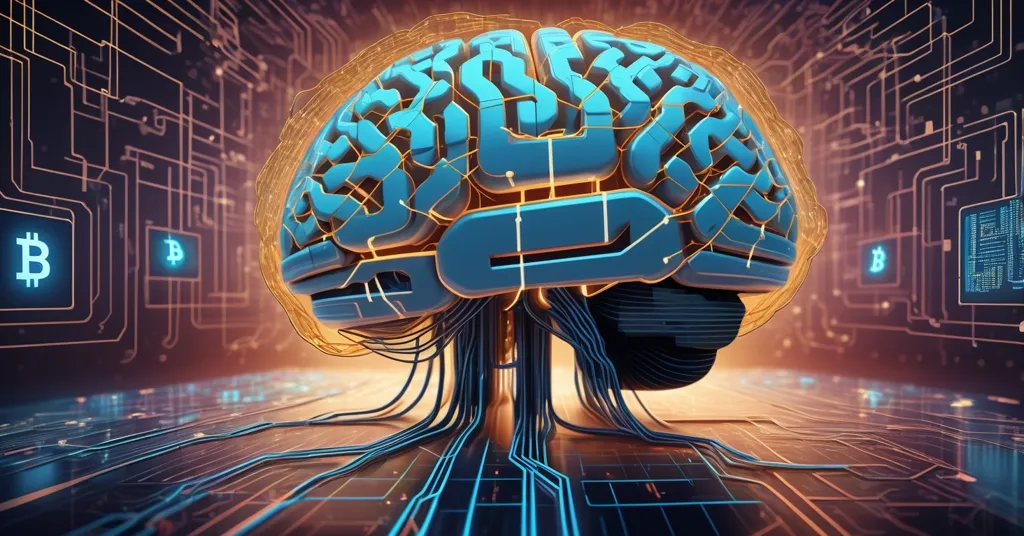DeepSeek V3.1: AI Breakthrough for Blockchain and Crypto Disruption?

DeepSeek V3.1: Can AI Innovation Fuel Blockchain and Crypto Disruption?
Chinese AI innovator DeepSeek has unleashed its V3.1 model, boasting performance upgrades over its R1 predecessor and a pricing strategy that undercuts giants like OpenAI and Anthropic. Beyond the tech headlines, could this hybrid reasoning powerhouse spark new possibilities for blockchain and cryptocurrency, or is it just another flashy distraction?
- Performance Leap: V3.1 introduces hybrid reasoning with thinking and non-thinking modes, outshining R1 on key benchmarks.
- Price Slash: API costs as low as $0.07 per million tokens challenge industry norms, offering affordability for crypto projects.
- Blockchain Potential: Agent capabilities hint at game-changing applications for decentralized tech—if limitations are addressed.
DeepSeek V3.1: What’s Under the Hood?
DeepSeek made waves with its V3.1 model announcement via a WeChat post, marking another step in China’s mission to rival Silicon Valley’s AI dominance. Building on the success of R1, launched in January and hailed as a challenger to U.S. firms, V3.1 brings a hybrid reasoning architecture to the table. This means users can toggle between “thinking” and “non-thinking” modes using a “Deep Thinking” button on DeepSeek’s app and website. For those new to AI lingo, think of it like flipping between deep brainstorming for a complex problem and quick mental math for a grocery bill—two gears for different needs. The thinking mode prioritizes in-depth analysis for tough tasks, while non-thinking mode churns out fast, simple answers.
On the performance front, data from Artificial Analysis gives V3.1 a slight edge, scoring 60 on the intelligence index in reasoning mode compared to R1’s 59, while using fewer tokens—a nod to efficiency. It shines on benchmarks like SWE, focused on software engineering tasks, and Terminal-Bench, which tests command-line problem-solving, making it a handy tool for coders. Yet, before we crown it king, let’s be real: V3.1 still trails behind heavyweights like Alibaba’s Qwen models and OpenAI’s GPT-OSS in raw power, as seen in detailed performance comparisons. A notable shortfall is the absence of function calling in reasoning mode—a feature that lets AI autonomously execute tasks or link with other systems, often called “agentic workflows.” For blockchain developers eyeing V3.1 for smart contract automation, this gap stings. Built on the same framework as R1 with 671 billion total parameters (think of these as the AI’s “brain cells”) and 37 billion active ones, the update feels more like a tune-up than a revolution. Still, for its weight class, it’s throwing some serious punches.
Pricing Power Play: A Win for Crypto Devs?
DeepSeek isn’t just flexing tech muscle—it’s swinging a wrecking ball at industry pricing. Effective September 6, its new structure sets Input API at $0.07 per million tokens for cache hits and $0.56 for misses, with output tokens at a laughably low $1.68 per million. Stack that against OpenAI’s GPT-5 or Google’s Gemini 2.5 Pro, both at $10 per million for output, or Anthropic’s Claude Opus 4.1, which can hit a wallet-bruising $75 per million. This isn’t competition; it’s a punk-rock rebellion against bloated standards, the kind of move Bitcoin OGs might smirk at with approval, as discussed in a recent market impact analysis.
For blockchain and crypto projects, often bootstrapped and budget-tight, this could be a lifeline. Imagine slashing costs for AI-driven decentralized finance (DeFi) tools, like predictive analytics for yield farming or trading bots on Ethereum. At these rates, smaller devs—not just corporate whales—could experiment with AI for on-chain solutions without bleeding cash. It’s a step toward democratizing tech, much like Bitcoin aimed to do with money. But let’s not get starry-eyed—low cost doesn’t mean zero risk. Relying on bargain-basement APIs for critical operations like smart contract triggers could invite security holes or uptime snafus. In the crypto game, a single glitch can mean a rug pull of epic proportions. Cheap is sweet, but trust is sweeter.
Hardware Hiccups: A Stumbling Block
DeepSeek’s path isn’t all smooth sailing. The hyped R2 model, initially pegged for a May 2025 rollout, is stuck in limbo thanks to technical snags with Huawei’s Ascend processors, as reported in recent industry updates. Even with Huawei engineers on-site, problems like slow inter-chip connectivity, shaky stability, and software mismatches have bogged down training. As a result, DeepSeek leans on Nvidia chips for training while using Huawei’s gear for inference—basically, deploying the model for real-world use after it’s built. This split reliance exposes a raw nerve in China’s tech ecosystem: despite government pressure to go domestic and ditch foreign dependency, Huawei’s hardware can’t yet match Nvidia’s polish.
For the crypto crowd, this matters more than it might seem. If hardware bottlenecks delay or degrade DeepSeek’s future models, scaling AI for blockchain apps—say, real-time fraud detection on Bitcoin’s Lightning Network—could hit a wall. China’s push for self-sufficiency echoes our own fight against centralized financial control, but tech hiccups remind us that freedom isn’t free. DeepSeek’s founder, Liang Wenfeng, isn’t speeding things up either. Reports paint him as a perfectionist, holding off R2’s launch until it meets his exacting standards. Admirable, maybe, but in a race where Alibaba and Tencent drop updates like hotcakes, stalling could cost dearly.
Blockchain Breakthroughs: Where AI Meets Decentralization
Now, let’s get to the juicy bit—why should Bitcoiners and blockchain buffs care about some AI model from China? V3.1’s enhanced agent capabilities, built for task execution and problem-solving, open a door to decentralized applications (dApps) that could redefine crypto’s frontier. Picture an AI agent running on-chain, managing liquidity pools in DeFi protocols at a fraction of today’s API costs. Or consider tokenized data marketplaces where low-cost AI handles privacy-preserving computations—no central server snooping required. These ideas vibe with effective accelerationism, the push to fast-track tech that disrupts the status quo, much like Bitcoin did to banks, aligning with broader trends in AI-driven blockchain innovation.
Drill down further, and use cases multiply. NFT marketplaces could tap V3.1 for real-time trend analysis, helping creators price digital art dynamically. On Bitcoin-adjacent layers like Lightning, AI could flag suspicious transactions instantly, bolstering security without human lag. Ethereum devs might leverage it for smarter contract automation, cutting gas fees by optimizing logic upfront. The cost savings alone—pennies compared to OpenAI’s dollars—could empower underdog projects to compete with the big dogs. It’s the kind of leveling we root for in the crypto space, where innovation shouldn’t be a rich man’s toy, and many are exploring blockchain applications for V3.1.
Yet, let’s play devil’s advocate. Performance gaps mean V3.1 might struggle with complex on-chain tasks compared to pricier rivals. And while the pricing screams accessibility, can we trust the outputs for mission-critical ops like multi-million-dollar DeFi trades? One bad call from an AI bot, and you’re liquidated faster than you can say “HODL.” We’re all for disruption, but half-baked tools won’t cut it in a space allergic to failure.
Risks and Red Flags: The Dark Side of Integration
Before we get too cozy with DeepSeek, let’s shine a light on the shadows. The biggest red flag for any self-respecting Bitcoiner is centralized infrastructure. Whether it’s Huawei or Nvidia chips, V3.1’s backbone isn’t decentralized—and that’s a problem. In a world where privacy and freedom are non-negotiable, tying blockchain projects to hardware potentially influenced by state or corporate agendas is a gamble. Huawei’s past, with bans in Western nations over backdoor fears, doesn’t exactly scream “trustworthy.” If DeepSeek’s tech comes with hidden strings, any crypto integration risks tainting our core ethos of sovereignty, a concern echoed in discussions about its impact on crypto projects.
Then there’s the open-source question—or lack thereof. Community buzz hints that DeepSeek might lean open-source, letting anyone peek under the hood, but official silence leaves us guessing. For a crowd that preaches “don’t trust, verify,” this opacity is a hard pass. Without transparency, integrating V3.1 into dApps or Bitcoin tools feels like handing your private keys to a stranger. Add to that China’s broader tech surveillance rep, and you’ve got a recipe for paranoia. Could state-tied hardware log data from AI-driven crypto trades? It’s not far-fetched, and history backs the skepticism. We champion innovation, but not at the cost of selling out decentralization’s soul. For more background, check the detailed overview of DeepSeek’s models.
Key Takeaways and Questions
- What sets DeepSeek’s V3.1 apart in the AI landscape?
Its hybrid reasoning with thinking and non-thinking modes, paired with rock-bottom pricing at $1.68 per million output tokens, makes it a standout against pricier players like OpenAI and Anthropic. It’s a budget-friendly powerhouse for those willing to overlook some performance gaps. - How could V3.1 transform blockchain and crypto projects?
With dirt-cheap API access and agent capabilities, it could fuel cost-effective dApps, from DeFi trading bots to NFT analytics. This affordability might lower barriers for small devs building on Ethereum or Bitcoin layers, driving wider adoption. - What risks come with blending DeepSeek’s AI into decentralized tech?
Centralized hardware ties to Huawei or Nvidia clash with crypto’s privacy ideals, raising backdoor concerns. Unclear open-source status and potential state oversight further erode trust for Bitcoiners who prioritize sovereignty above all. - Why are DeepSeek’s R2 delays a concern for crypto integration?
Hardware issues with Huawei’s Ascend chips signal scalability hurdles that could slow AI tools for blockchain. If future models like R2 stumble, crypto devs banking on seamless AI upgrades might face roadblocks. - Does DeepSeek align with Bitcoin maximalist principles?
Its disruptive pricing and jab at Western tech dominance resonate with Bitcoin’s anti-establishment roots. Yet, centralized dependencies and privacy doubts make it a tough sell for purists obsessed with self-sovereignty. - Can AI like V3.1 revolutionize cryptocurrency trading?
Potentially, by powering low-cost bots for real-time market analysis or trade execution on platforms like Ethereum. However, performance limits and trust issues mean it’s not a silver bullet—traders beware of untested tech.
DeepSeek’s V3.1 lands as a bold contender, mixing raw innovation with a price tag that screams opportunity. For the blockchain and crypto community, it’s a tantalizing peek at how AI could supercharge decentralization—slashing costs for dApps, smart contracts, or on-chain security. This aligns with our hunger for tools that dismantle barriers, echoing Bitcoin’s own underdog fight against financial gatekeepers. But the flip side looms large: centralized hardware, murky transparency, and performance shortfalls keep skepticism alive. China’s AI ambitions mirror our push against centralized control, yet the devil hides in the dependencies. Could DeepSeek evolve into an unlikely ally for Bitcoiners, prioritizing privacy and open frameworks in future models like R2? Or is it just another tech hype train, destined to derail under its own contradictions? Keep your eyes sharp and your nodes running—the intersection of AI and crypto is heating up, and the stakes couldn’t be higher, especially with insights into V3.1’s pricing and potential for decentralized tech.



